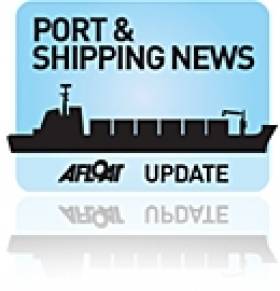Displaying items by tag: Irish Lights tender
Lighthouse Tender of Almost Two Decades Directly Docks at Irish Lights HQ in Dun Laoghaire
#DirectDock - ILV Granuaile the Commissioners of Irish Lights tender today directly docked alongside the aids to navigation authority HQ in Dun Laoghaire Harbour which involved weaving a navigation around the inner harbour’s marina, writes Jehan Ashmore.
The docking of ILV Granuaile this morning at Irish Lights striking joint administration and marine maintenance depot was for general operational work which includes the exchange of various types of navigation buoys as when required. The use of pulling along the depot's quay is relatively normal otherwise the routine berth for ILV Granuaile whose homeport is the harbour is that of nearby St. Micheals Wharf. In these circumstances the vessel's own tenders assist in transferring equipment to and from the depot.
As for the ships prefix, ILV Granuaile, this stands for Irish Lights Vessel which was built in 2000 in Romania at the Dutch owned Damen Shipyards at Galati from where she entered the Black Sea. After refitting in the Netherlands, the 2,625 gross tonnage ILV Granuaile became a game changer for CIL in terms of design particularly with technology in the form of ‘dynamic positioning’. The use of DP mode enables superior shiphandling capabilities for pinpoint deployment of navigational aids and notably in confined quarters.
In the year of the new millenium a maiden delivery voyage to Dun Laoghaire Harbour took place almost 17 years ago in January 2000. The ship has a crew of 16 personnel. She is the first 'custom' built tender of all three General Lighthouse Authorities (GLA's) to have a ship configuration layout of working deck aft and superstructure amidships / forward. Asides Irish Lights the other GLA's are Trinity House (England & Wales) and Northern Lights (Scotland & Isle of Man) serving these waters.
The ILV Granuaile had previously today arrived from Belfast to berth at St. Michaels Wharf and has since returned this afternoon. It is on the adjacent quay where former Holyhead fast-ferry HSS Stena Explorer was in use until seasonal sailings finally ended in September 2014. This was followed by an official announcement by Stena to confirm no service would return in 2015 and hence their withdrawal ending the historic era of the Welsh ferry link. This left ILV Granuaile as the only large commercial vessel regularly using Dun Laoghaire Harbour.
As Afloat highlighted the former ferry terminal is available to let, noting yesterday was the final day for proposals and offers to rent the entire building. Asides ILV Granuaile, St. Michaels is host to the small commercial excursion vessel St. Bridget operated by Dublin Bay Cruises whose main season linking also Dublin Port and Howth Harbour ceased in late summer. Festive cruises however are running just in Dublin along the River Liffey and on occasions up to the port's Poolbeg Lighthouse.
It should be noted that during the majority years of ILV Granauile career, the vessel would also moor close to the western bight within Dun Laoghaire Harbour. From an anchorage, buoys would be towed back and forth from the ship and marine depot ashore. This practise albeit romantic involved tug-buoy tender Puffin though this entailed a more time-consuming and expensive process.
Puffin was subsequently sold in 2011 to Shannon Workboats and in which Afloat took a trip on board the Bristol-built boat from Rusal's Aughinish Alumina plant jetty to Foynes Port. By coincidence the hull colour of Puffin changed from grey to blue likewise of her former larger fleetmate.
The tender boat name unchanged has been noted recently berthed at the Claddagh beside Galway Port.
Cork Dockyard Contract of Irish Lights Vessel Faced Stiff Competition from European Yards
#CorkDockyard – ILV Granuaile, the Commissioners of Irish Lights aids to navigation tender departed Cork Dockyard's graving dock today, following a major work contract won in the face of stiff competition from European yards, writes Jehan Ashmore.
The ILV Granuaile in the presence of local tugs made a lunchtime exodus of the graving dock. She then went alongside the layby berth of the 44-acre facility in Rusbrooke where 30 years ago the last ship built by the former Verolme Cork Dockyard was launched.
According to CIL, the contract won by Cork Dockyard Ltd (part of the Doyle Shipping Group) was secured from competing yards in the UK and France. The contract for a '15 year Special Survey and Drydocking' followed a competitive EU tender and is part of an overall €650,000 project to so to enable continued operation of the ship to Lloyds +100A1 Classification.
The yard's work was to carry out hull and superstructure painting, repair tasks and major tank surveys. As well to this overhauls to both Schottel and bow thrusters were required plus an inspection of the hull's plate thickness.
ILV Granuaile entered the 165.5m (539ft) by 22.5m (73ft) wide graving dock in late August, having engaged on an international charter working on wind farms in the German Bight and in waters off the Netherlands.
Prior to her arrival, Granuaile which was custom-built for CIL in Romania by the Dutch Damen Group, made an en route call to Rosslare before entering the graving dock in lower Cork Harbour.
Granuaile is designed to service all aids to navigation off the island of Ireland in which there are 300 general aids and some 4000 local aids.
In addition to the occasional commercial charter work, she has also been tasked to undertake operations with other state agencies such as the Naval Service, Coast Guard and Marine Institute.
She is due to return to routine duties off the west coast, however due to strong demand according to CIL her services will again be required for a joint project.
This will see the 2,625 tonnes vessel carry out work for the Marine Institute and SEAI, where sensors to monitor wave energy activity will be deployed at SEAI's offshore wave energy test site off Belmullet, Co.Mayo.





























































